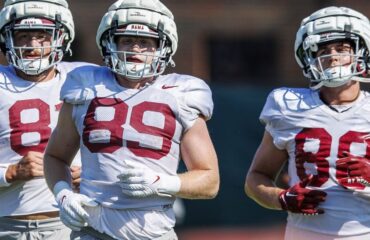“It’s a critical piece of our offense,” Alabama coach Kalen DeBoer said about the tight end position. “It always has been, going back 20-plus years. Having that guy that doesn’t just control the middle of the field, but can get vertical and stress you to the sidelines.”
As Alabama prepares for 2024, there’s a lot of intrigue surrounding the offense—Jalen Milroe’s growth at quarterback, the potential of the running backs, Ryan Williams at receiver, the offensive tackle battle, and more.
The tight ends, however, aren’t getting much attention. They’re just a group of large, hard-working players with a lot of experience but not much receiving production. Their role remains somewhat uncertain.
“They’re critical,” DeBoer emphasized after the Crimson Tide’s fourth fall camp practice, repeating the word to stress their importance.
Last year, Alabama’s tight end room was highly regarded. With Tommy Rees as offensive coordinator, many expected great things from the tight ends, given his success at Notre Dame with multiple tight end sets. At Notre Dame, Rees coached Michael Mayer, an All-American who became an NFL starter.

The Tide’s offense performed better with multiple tight ends on the field, but they were mostly used as blockers. Excluding Amari Niblack, Alabama’s top receiving tight end last year (now at Texas), the tight ends were used as blockers on 74% of their snaps in 2023, playing nearly 1,000 total snaps combined, according to Pro Football Focus.
With DeBoer and offensive coordinator Nick Sheridan now at Alabama, their pro-spread offense has also arrived. While coaching at Washington last season, the Huskies went 14-1 and reached the national championship game, finishing No. 12 nationally in total offense and No. 13 in scoring offense.
Washington’s success was driven by quarterback Michael Penix Jr. and receivers Rome Odunze, Ja’Lynn Polk, and Jalen McMillan, all of whom became top-100 picks in the 2024 NFL Draft. However, tight end Jack Westover also contributed with 46 catches for 433 yards and 4 touchdowns. Devin Culp, TE2, added 16 catches for 208 yards and 2 scores.

“They have to know the whole offense,” DeBoer said of the tight ends. “One tight end, two tight ends, they give us extra gaps in the run game, they can help us in protection, they’re guys that can stretch the field and make some big plays that way.”
Throughout his coaching career, DeBoer has used tight ends in various ways depending on the personnel and overall offense. Westover and Culp were supporting players in Washington’s offense last year. At Indiana in 2019, DeBoer used Peyton Hendershot as a primary receiving option, who finished with 52 catches for 622 yards and 4 touchdowns for the 8-win Hoosiers. At Fresno State in 2020-21, three tight ends—Tre Watson, Raymond Pauwels Jr., and Juan Rodriguez—were behind other skill players in the offense.
DeBoer has carved out different roles for his tight ends depending on the team, but the position remains an important part of his playbook.
“It’s a critical piece of our offense,” DeBoer reiterated. “Having that guy that doesn’t just control the middle of the field but can get vertical and stress you to the sidelines, so both a vertical and horizontal stretch. They have to know the whole offense… really important, not just in our run game but in our pass game.”
Alabama’s tight end room doesn’t have the same star power as other skill groups. CJ Dippre is the headliner, followed by Robbie Ouzts and Josh Cuevas, who followed DeBoer from Washington. These three combined for 18 catches for 384 yards and two touchdowns in 2023.
Despite lacking returning production, they bring a lot of experience. Alabama’s current tight end room played 1,095 total snaps in 2023, more than the running back and wide receiver rooms combined (1,068, excluding the 155 snaps from Jalen Hale, who is expected to miss the 2024 season).
“There are good players in that room,” Sheridan said. “They’re competing their tail off.”

Through four fall camp practices, it’s difficult to determine the positional hierarchy, but Dippre and Ouzts were the first names Sheridan mentioned when asked about the group’s development. Behind them are Cuevas, Danny Lewis Jr., Ty Lockwood, and true freshman Jay Lindsey. The depth is a positive.
“Every place we’ve been, you need four players that can contribute and play in a game,” Sheridan continued. “How many snaps, what that looks like will be determined, but I feel good about that room… we’re going to need them all.”
DeBoer didn’t specify the exact role Alabama’s tight ends will play in 2024—whether as primary receiving options, versatile supporting players, or extra blockers—but he noted that the group has learned the offense quickly.
“They’re all really smart guys that have caught on quickly,” DeBoer said. “All the moving pieces we want to do with them, we haven’t held back at all.”
It may take the fall camp scrimmages or even Week 1 against Western Kentucky to see how Alabama’s tight ends will be utilized in the 2024 offense.






